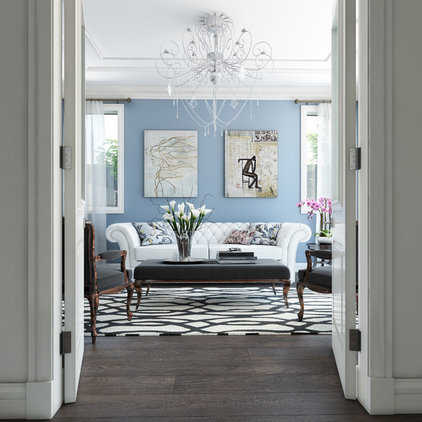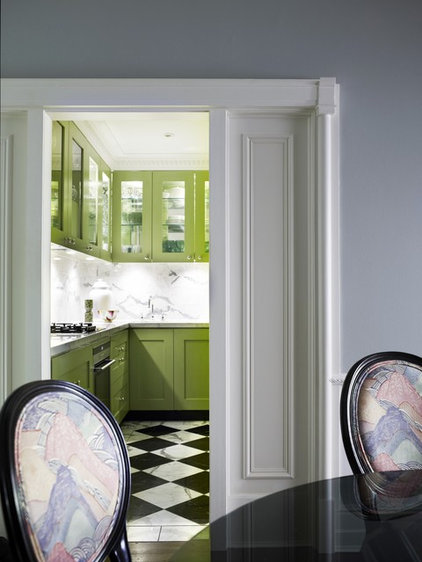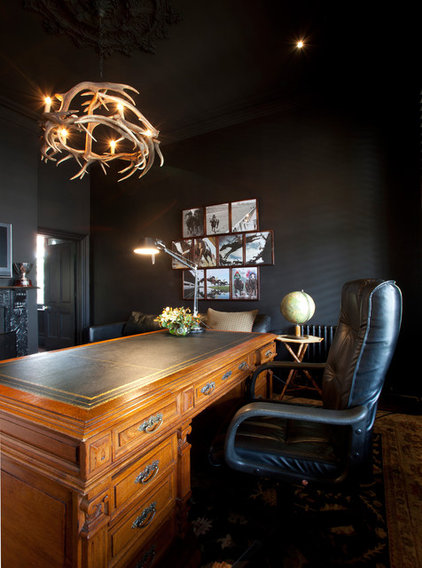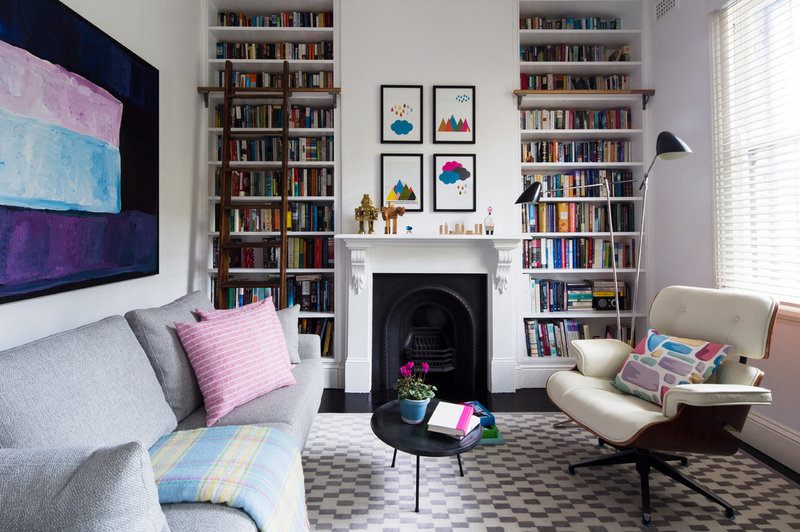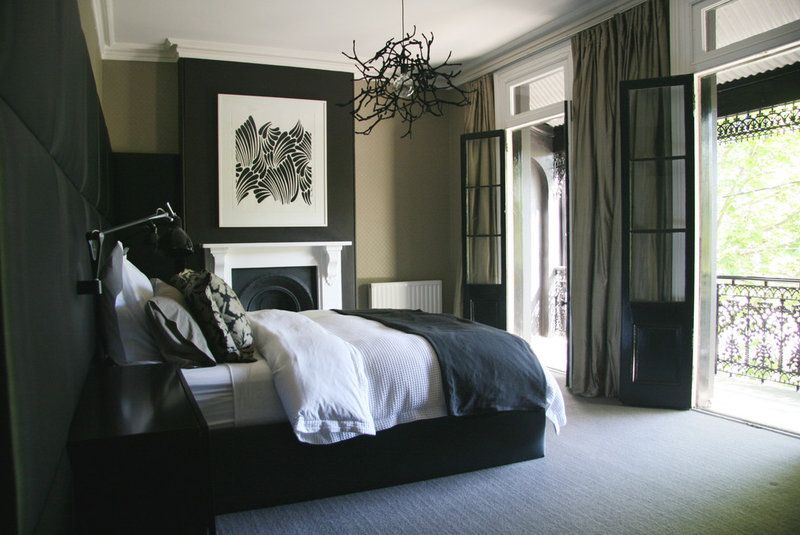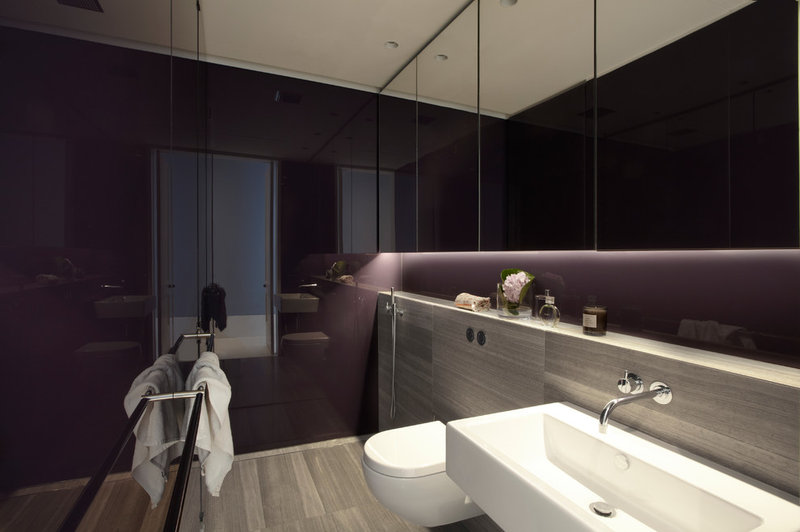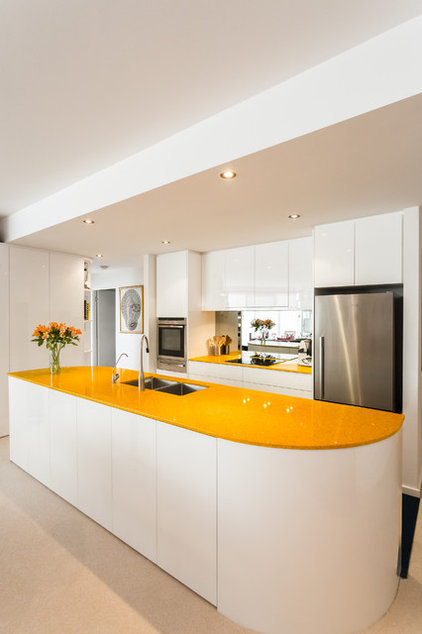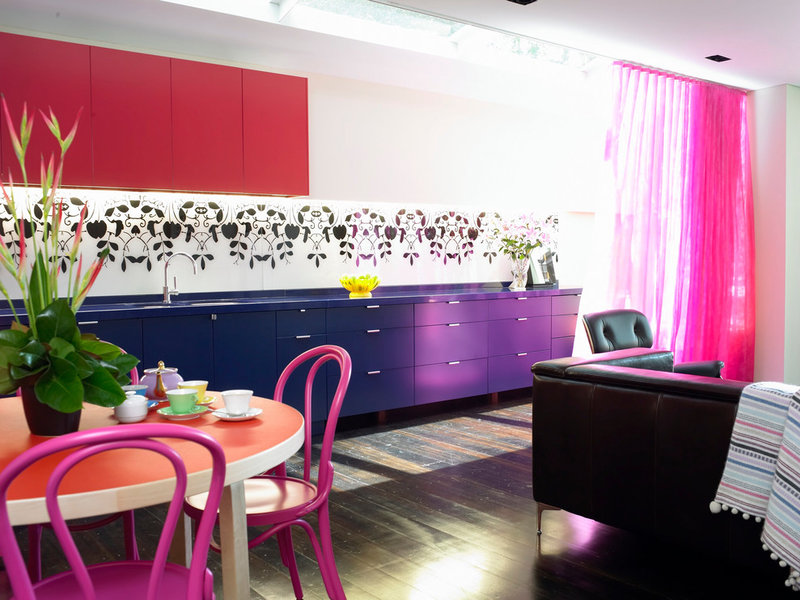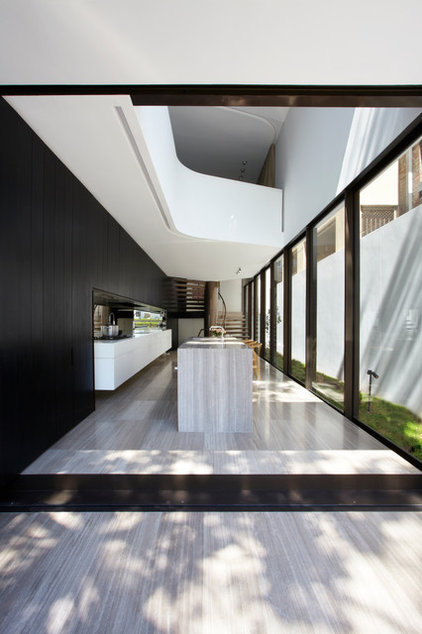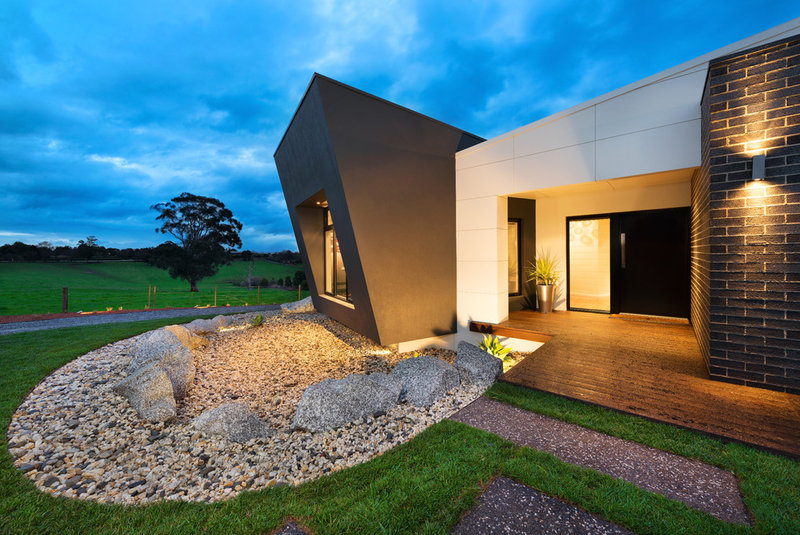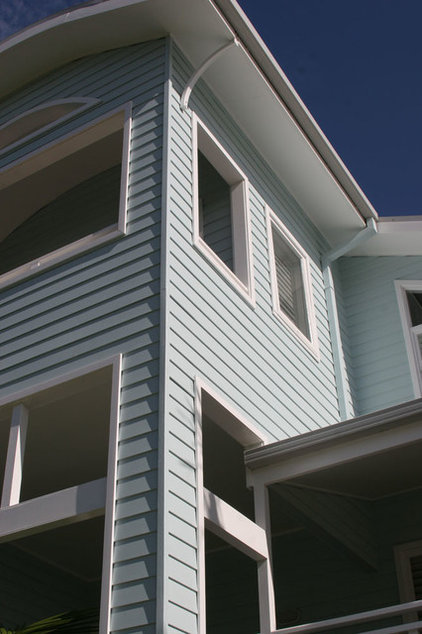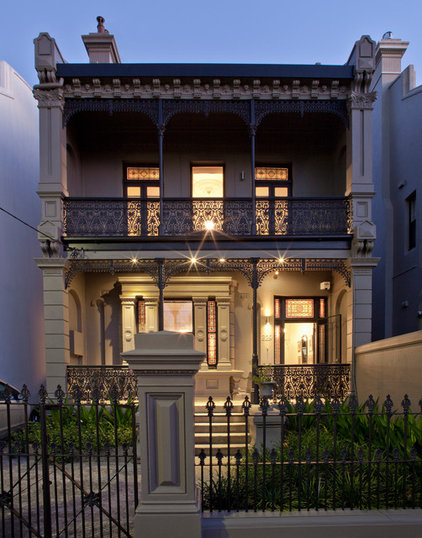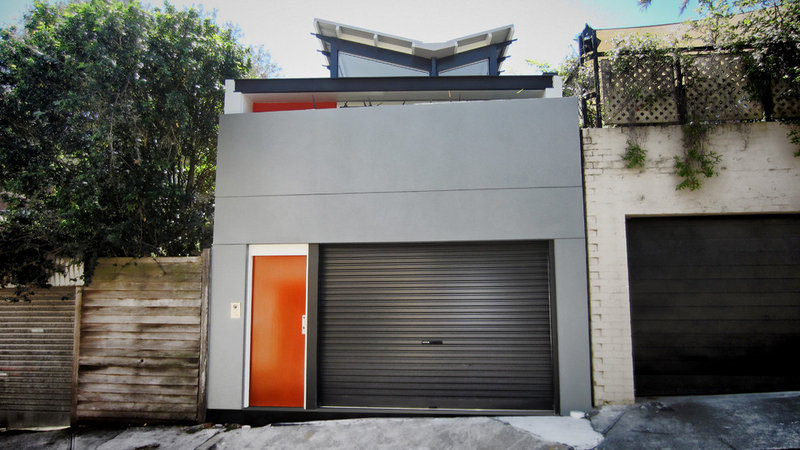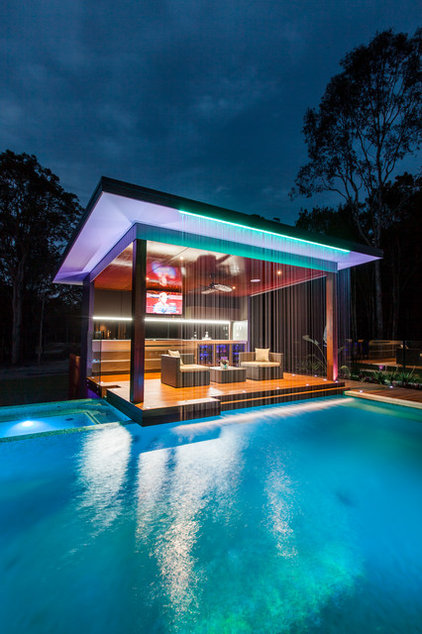If I could write this ideabook in color, I probably would. Color
almost always captures the mood, the personality and the energy of the
space you are creating, and even more that of the creator. You can tell a
lot about people from the way they dress, the color of their shoes or
the print on their shirt. A house is no different — color both inside and outside the home will provide you with a glimpse of the type of person who lives there. After
all, what we wear is a reflection of who we are, and how we use color
in our homes most certainly reflects what we want our houses to be.
So
what do you want to tell the world? And how much color should be used?
Well, the amount of color depends on what mood you are trying to set or
what personality you are trying to convey. Did you know that red raises
the energy in a room, while green and blue are restful, serene and
relaxing colors? Or that purple is associated with sophistication, drama
and luxury, while black is the color of authority and power and, at the
same time, stylish and timeless? Color is an individual preference and
will not always be universally liked, and too much of a color can have
the opposite effect of what you are trying to achieve. The tips below
will show you how to use color with restraint to create a beautiful home.
Color in anticipation. If
you were walking down this hallway toward these double doors that are
open, there is no doubt you would be drawn into the room. The interior
designers at
Destination Living very
cleverly showed restraint with their color palette. The soft blue of
the walls, in contrast with the white color scheme, beckons you inside
in anticipation of what lies beyond. Choosing only one color can be so
difficult; however, I have no doubt that the mood the designers wanted
to create by using only blue was one of peace and tranquility.
Colors that are opposites. They say that blue and green should never be seen next to each other. Someone forgot to tell
Greg Natale! This color scheme shows the sophistication and skill not only
of Natale but also of the homeowner, who showed great faith in the designer to capture a particular mood.
From
the soft blues of the dining room walls to the soft greens of the
kitchen cabinets that sit on a black and white checkerboard floor, this
look transports me back to my childhood in the ’70s, when this color
scheme adorned my own home, but not in such a dramatic manner. You just
want to walk through those doors to see what else is happening.
Color to make a statement. Hand
in the air if you would ever dare paint a room a single color — not
only the walls and ceiling but also the architraves, trim, door,
cornices and ceiling medallion. Oh, and that color is black. Even the
hydronic heater and marble fireplace are black.
The interior designers at
Mr. Mitchell not only showed remarkable restraint in their use of color, but they have told us a lot about the homeowners.
The color black provides a backdrop for all of their worldly possessions and makes a statement about who they are.
Remember in my opening paragraph when I mentioned that black is a color
of authority and power? The interior styling of this room helps
reinforce the use of the color black to tell a story, from the bold
timber period desk and leather chair to the world globe and horse racing
prints on the wall, to the prized winner’s cup on the fireplace mantel.
Finally, far from using a period pendant, the designers have chosen
what looks like a contemporary design: a light fitting made of antlers.
Zero color. There are times when no color is the appropriate solution. (Even though white is actually a color.)
Horton & Co. Designers not only
has created
a tranquil mood in this room, but has provided us a glimpse of the
personality of the homeowners. There is no doubt that this is a reading
room, because the books take center stage and provide all the color. The
soft fabrics and the print on the wall add additional highlight colors,
taking their cue from the vast book collection.
If a room is
going to be filled with objects that contain a lot of color, it is
important not to add additional colors on the walls, or all of the
objects will recede into the background and any impact will be lost.
Colors from the same palette. I
could almost tell you the color of the exterior of this house without
seeing an exterior photo. Colors from the same palette allow you to
create a mood. So how much color did the designers at
Darren Palmer Interiors
use? Well, at the outset you would say two: black and a dark taupe.
However, there are other colors that also come into play, white on the
ceiling and gray in the carpet. Shadows also add color by changing the
shade of one wall to another. Remember that when you choose the number
of colors you want to use in a space, some other colors will naturally
come into play, so try not to highlight too many colors, or your message
will be lost.
Color that reflects. As in the previous photo, there appear to be only a couple of colors in this bathroom design. However, the architects at
Smart Design Studio
realized that reflective glass and mirrored surfaces would create depth
and color by their inherent characteristics. Even the tiles have a few
shades of taupe, and there are also a couple of whites — the white of
the porcelain fixtures and the white of the ceiling. You think there are
only two colors chosen, but look how many actually appear.
Color to highlight. In this kitchen design, the cabinetry specialists at
KTC Design
wanted to highlight the unusual countertop color. To draw attention to
the countertop and make it the focal point, the designers kept the
palette of the cabinets, other features and walls neutral. Had they
chosen to use other highlight colors in this room, then the focal point
of the countertop would have been lost.
Color for personality. I love this space, because the architects at
Scott Weston Architecture Design obviously
had a strong brief from their clients on how the space should reflect
who they are. There are so many colors in this room, in the furnishings,
cabinetry, curtains and even the potted plant. There was no need for a
color selection for the walls except for a not-so-subtle black print
that provides further evidence of the homeowners’ personality. You just
want to know what all the other rooms in this house look like.
Remember,
though, that this color palette is not for everyone. Some would argue
that no restraint was shown, but that is far from the truth.
Considerable thought was given to coordinating the color of the chairs
to match the curtains, and the color of the tabletop to match that of
the overhead cupboards. Color is an individual preference and a
reflection of you.
See more of this home
Color to create drama. There
are times as an architect when you want to highlight the architectural
forms of a space in a dramatic fashion. This contemporary kitchen, which
is sculptural in form, was designed by
Smart Design Studio,
and the drama of the space was created through careful restraint in the
color selection. To highlight the individual architectural elements,
color contrasts were created. For example, the white recessed cabinets
clearly stand out against the dark paneled wall. The sweeping white
curved mezzanine above is also highlighted against this same dark wall.
The
designers also realized that to limit the color selection, they would
also need to limit the material selection for the tiles and countertop,
as those could introduce yet more colors. Therefore, the same stone
material was used for the floor and the kitchen
countertop.
The only hint of a foreign color is the green of the grass following
the same line down the side of the building, but that, too, is
contrasted against the white wall.
Color to highlight form. If
you want to hide an architectural form, you simply paint it the same
color as the rest of the house. However, if you want to show off the
form, you paint it a different color altogether. The team at
Design Unity wanted
to
express the bold, angled form on this house that sits proud on the
facade, so what better way to do it than give it a strong color that
contrasts with the white adjacent walls? Had they introduced just one
other color, the message would have been lost. Even the landscape design
supports the architectural form.
Color to highlight architectural elements. External
architectural elements that homeowners want to highlight, such as
fretwork, are often painted a contrasting color to the rest of the
facade. This is seen in many period homes.
So how many colors do
you highlight? Many homeowners go for authenticity in the restoration
process. Some Victorian and Edwardian homes, for example, display many
colors to highlight the roof, gutters, fretwork, corbels, fencing and
so on. There is usually a vast amount of literature on these types of
homes to help you restore them to the original color scheme and allow
you to identify the architectural style.
Even in this contemporary timber home, the interior designers at
The Space Within highlighted
the craftsmanship of the woodwork against the boldness of the facade by
choosing one color only to help express the difference. The
introduction of a third color on the outside of this home would have
disrupted the purity of the design.
Color for luxury. I have
always believed as an architect that if you want to make a house look
expensive, choose one color or two at an absolute maximum, with the
second color used sparingly. So, for example, paint the facade, fence,
windows, even the downpipes, all the one color. Don’t differentiate.
You
should also choose a color that exemplifies sophistication, luxury and
style. If you take a drive around the most affluent suburbs in
Australia, you will notice that many of these homes wear a single color.
Their fences, walls, fenestration etc. are all one color. As an
analogy, it’s like wearing a timeless black suit or dress — it’s all one
color and looks sophisticated. As you can see, the builders at
To the Mil have
made this home look luxurious with the use of one main color, and a second color is used only to highlight.
Color as identity. There are times when you have to show the world where to go.
Michelle Walker
used color successfully to identify not only this entrance door but
also the garage in this nondescript facade that sits flush on the street
boundary. Sometimes you just have to be bold and direct.
Color by day and night. Choosing
the right color and the amount of color to use both inside and outside a
house is not easy, and that’s why professionals are the go-to people —
they have the experience to showcase
not only your house but your personality as well, and create just the right mood.
Here the experts at
Interiors By Darren James
used not only color but light to create the right mood for this amazing
poolside setting. Did you know that individual colors look completely
different under a different light? The contrast can be amazing.
Taubmans
has a color lighting tool on its website — you can select a color and
instantly see how it changes under the influence of different lighting.
